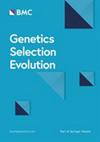SIRE 2.0: a novel method for estimating polygenic host effects underlying infectious disease transmission, and analytical expressions for prediction accuracies
IF 3.1
1区 农林科学
Q1 AGRICULTURE, DAIRY & ANIMAL SCIENCE
引用次数: 0
Abstract
Genetic selection of individuals that are less susceptible to infection, less infectious once infected, and recover faster, offers an effective and long-lasting solution to reduce the incidence and impact of infectious diseases in farmed animals. However, computational methods for simultaneously estimating genetic parameters for host susceptibility, infectivity and recoverability from real-word data have been lacking. Our previously developed methodology and software tool SIRE 1.0 (Susceptibility, Infectivity and Recoverability Estimator) allows estimation of host genetic effects of a single nucleotide polymorphism (SNP), or other fixed effects (e.g. breed, vaccination status), for these three host traits using individual disease data typically available from field studies and challenge experiments. SIRE 1.0, however, lacks the capability to estimate genetic parameters for these traits in the likely case of underlying polygenic control. This paper introduces novel Bayesian methodology and a new software tool SIRE 2.0 for estimating polygenic contributions (i.e. variance components and additive genetic effects) for host susceptibility, infectivity and recoverability from temporal epidemic data, assuming that pedigree or genomic relationships are known. Analytical expressions for prediction accuracies (PAs) for these traits are derived for simplified scenarios, revealing their dependence on genetic and phenotypic variances, and the distribution of related individuals within and between contact groups. PAs for infectivity are found to be critically dependent on the size of contact groups. Validation of the methodology with data from simulated epidemics demonstrates good agreement between numerically generated PAs and analytical predictions. Genetic correlations between infectivity and other traits substantially increase trait PAs. Incomplete data (e.g. time censored or infrequent sampling) generally yield only small reductions in PAs, except for when infection times are completely unknown, which results in a substantial reduction. The method presented can estimate genetic parameters for host susceptibility, infectivity and recoverability from individual disease records. The freely available SIRE 2.0 software provides a valuable extension to SIRE 1.0 for estimating host polygenic effects underlying infectious disease transmission. This tool will open up new possibilities for analysis and quantification of genetic determinates of disease dynamics.SIRE 2.0:估算传染病传播所依赖的多基因宿主效应的新方法,以及预测精度的分析表达式
对不易受感染、感染后传染性较低、恢复较快的个体进行遗传选择,为减少家畜传染病的发病率和影响提供了有效和持久的解决方案。然而,从实际数据中同时估计宿主易感性、传染性和可恢复性遗传参数的计算方法一直缺乏。我们之前开发的方法和软件工具SIRE 1.0(易感性,传染性和可恢复性估计器)允许使用通常从实地研究和挑战实验中获得的个体疾病数据来估计单核苷酸多态性(SNP)或其他固定效应(例如品种,接种状态)对这三种宿主性状的遗传影响。然而,在潜在多基因控制的可能情况下,SIRE 1.0缺乏估计这些性状遗传参数的能力。本文介绍了新的贝叶斯方法和新的软件工具SIRE 2.0,用于估计宿主易感性,传染性和可恢复性的多基因贡献(即方差成分和加性遗传效应),假设谱系或基因组关系是已知的。推导了这些性状预测精度的解析表达式,揭示了它们对遗传和表型变异的依赖,以及接触群体内部和群体之间相关个体的分布。发现传染性的PAs严重依赖于接触群体的规模。用模拟流行病的数据验证了该方法,表明数值生成的pa与分析预测之间具有良好的一致性。传染性和其他性状之间的遗传相关性大大增加了性状PAs。不完整的数据(例如,时间审查或不频繁的采样)通常只能产生少量的PAs减少,除非感染时间完全未知,否则会导致大量减少。所提出的方法可以从个体疾病记录中估计宿主易感性、传染性和可恢复性的遗传参数。免费提供的SIRE 2.0软件为SIRE 1.0提供了一个有价值的扩展,用于估计传染病传播的宿主多基因效应。该工具将为疾病动力学的遗传决定因素的分析和定量开辟新的可能性。
本文章由计算机程序翻译,如有差异,请以英文原文为准。
求助全文
约1分钟内获得全文
求助全文
来源期刊

Genetics Selection Evolution
生物-奶制品与动物科学
CiteScore
6.50
自引率
9.80%
发文量
74
审稿时长
1 months
期刊介绍:
Genetics Selection Evolution invites basic, applied and methodological content that will aid the current understanding and the utilization of genetic variability in domestic animal species. Although the focus is on domestic animal species, research on other species is invited if it contributes to the understanding of the use of genetic variability in domestic animals. Genetics Selection Evolution publishes results from all levels of study, from the gene to the quantitative trait, from the individual to the population, the breed or the species. Contributions concerning both the biological approach, from molecular genetics to quantitative genetics, as well as the mathematical approach, from population genetics to statistics, are welcome. Specific areas of interest include but are not limited to: gene and QTL identification, mapping and characterization, analysis of new phenotypes, high-throughput SNP data analysis, functional genomics, cytogenetics, genetic diversity of populations and breeds, genetic evaluation, applied and experimental selection, genomic selection, selection efficiency, and statistical methodology for the genetic analysis of phenotypes with quantitative and mixed inheritance.
 求助内容:
求助内容: 应助结果提醒方式:
应助结果提醒方式:


